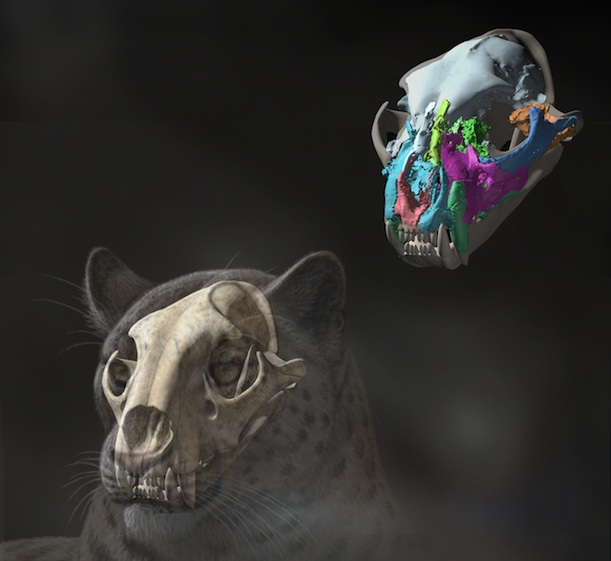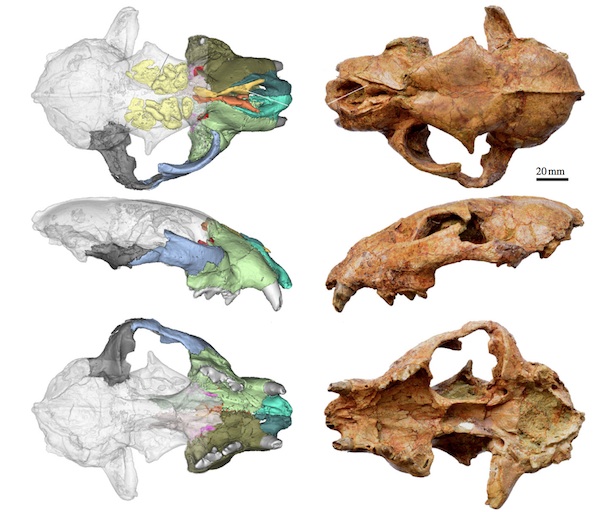
A reconstruction of the newly discovered species Panthera blytheae,
based on a skull discovered in Tibet that is estimated to be between
four and five million years old. Illustration by Mauricio Antón, Via Proceedings of the Royal Society B/Tseng et. al.
 To explore the valleys, the team drove up dirt trail after dirt trail
before coming upon a dense patch of fossils sticking out of the ground
halfway up a hill. “In the little concentration of fossils, there were
lots of limb bones from antelopes and horses obscuring everything else,”
says Tseng, who was then a graduate student at USC and is now with the American Museum of Natural History.
“It wasn’t until we started lifting things up, one by one, that we saw
the top of a skull, and we thought, from the shape, that it looked
something like a cat.”
To explore the valleys, the team drove up dirt trail after dirt trail
before coming upon a dense patch of fossils sticking out of the ground
halfway up a hill. “In the little concentration of fossils, there were
lots of limb bones from antelopes and horses obscuring everything else,”
says Tseng, who was then a graduate student at USC and is now with the American Museum of Natural History.
“It wasn’t until we started lifting things up, one by one, that we saw
the top of a skull, and we thought, from the shape, that it looked
something like a cat.”After a few years of analysis, Tseng’s team has discovered that the skull doesn’t belong to any old cat. As they’ve documented in a study published today in Proceedings of the Royal Society B, the skull and six associated fossilized jawbone fragments are the first evidence of a newly discovered species, which they’ve called Panthera blytheae. The discovery represents the oldest “big cat” (a group that includes large predatory cats like lions, jaguars, tigers and leopards) ever found by a wide margin.

CT scans (left) and photos (right) of the skull. Via Proceedings of the Royal Society B/Tseng et. al.
The new find fills a gap in the evolutionary record of big cats. By analyzing the DNA of living species, scientists had previously estimated that big cats had split from the Felinae subfamily—which includes smaller wild cats, like cougars, lynxes, along with domestic cats—about 6.37 million years ago. The very existence of P. blytheae confirms that the split happened prior to when this big cat roamed.
But how much earlier? The find could suggest, Tsang says, that big cats branched off from smaller cats much farther back than thought. By comparing the skull’s characteristics with fossils from other extinct big cats, the anatomy of living cat species, and DNA samples taken from both living cats and a few recently extinct, Ice Age-era species (known as cave lions), the researchers assembled a new evolutionary family tree for all big cats. Using known rates of anatomical changes over time and the observed anatomy of P. blytheae, they projected backwards, and estimated that the earliest big cats likely branched off from the Felinae subfamily between 10 and 11 million years ago.
The new fossil also solves a geological mystery. Previously, using DNA analysis of all living big cats and mapping the the fossils excavated from various sites around the world, researchers had determined it was most likely that their common ancestor had lived in Asia. The oldest known specimens, however, were found in Africa. The new species provides the first direct evidence that central Asia was indeed the big cats’ ancestral home, at least as far back as the current fossil record currently goes.
From the fragmented fossils, it’s hard to know much about the extinct species’ behavior and lifestyle, but the researchers were able to make some basic extrapolations from the skull’s anatomy. “It’s not a huge cat, like a lion or a tiger, but closer to a leopard,” Tsang says. The creature’s habitat was likely similar to the current Tibetan plateau, so Tseng speculates that, like the snow leopards that currently live in the area, this species did not hunt on the open plains, but rather cliffs and valleys. Tooth wear patterns also suggest similarities with current snow leopards—the rear teeth, likely used for cutting soft tissue, remain sharp, whereas the front teeth are heavily worn, perhaps reflecting their use in prying open carcasses and picking meat off bones.
Tseng says that he and colleagues plan to return to the area to search for more fossils that could help enlighten us on the evolutionary history of big cats. “The gap still isn’t completely filled yet,” he says. “We need to find older big cats to put the picture together.”
source
See also:
http://news.sciencemag.org/biology/2013/11/ancient-cat-may-reshape-feline-family-tree
http://www.theguardian.com/science/2013/nov/13/oldest-big-cat-fossil-tibet-predator-asia
http://www.newscientist.com/article/dn24561-himalayan-fossils-point-to-asian-origin-of-big-cats.html?cmpid=RSS|NSNS|2012-GLOBAL|online-news#.UoODL-JGaOB
No comments:
Post a Comment